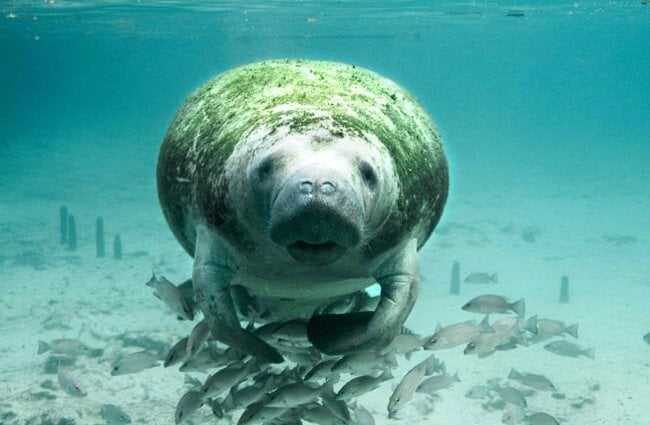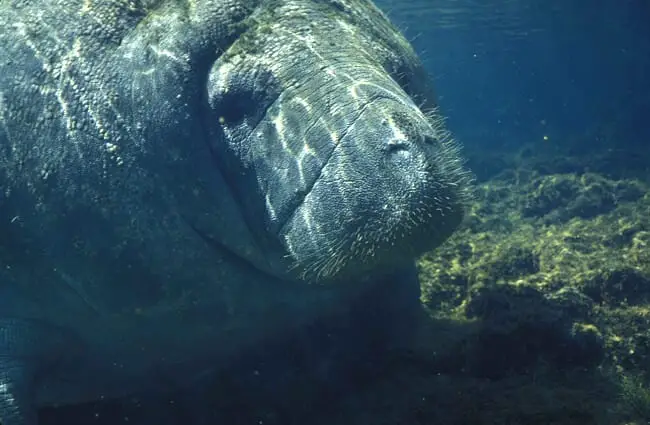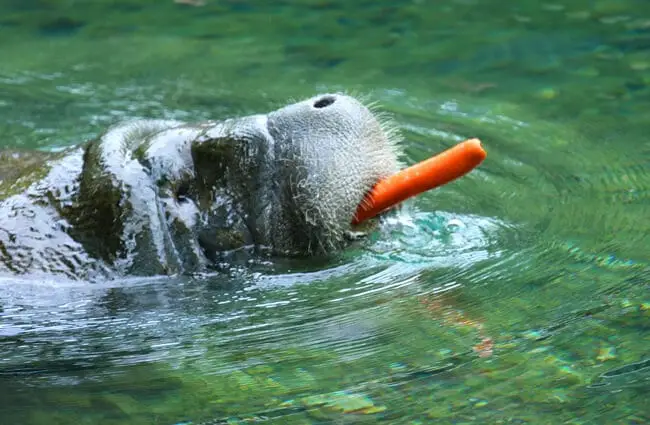Beneath the surface of warm, coastal waters, a creature of serene grace and immense power glides silently. Often mistaken for mythical mermaids by ancient mariners, the manatee, affectionately known as the “sea cow,” is a truly unique marine mammal. These gentle giants captivate with their placid demeanor and vital role in aquatic ecosystems. For students, aspiring zoologists, animal lovers, or even the casual observer, understanding the manatee offers a window into the delicate balance of our planet’s natural world.
This comprehensive guide delves into every facet of manatee life, from their ancient origins to their modern-day challenges, providing a wealth of knowledge for anyone eager to learn more about these magnificent creatures.
Who Are These Gentle Giants? Unpacking Manatee Basics
Manatees belong to the order Sirenia, a group of fully aquatic, herbivorous mammals that also includes dugongs. There are three recognized species of manatees, each inhabiting distinct geographical regions:
- West Indian Manatee (Trichechus manatus): This species is further divided into two subspecies: the Florida manatee (found in the southeastern United States) and the Antillean manatee (ranging through the Caribbean, Central America, and northern South America).
- Amazonian Manatee (Trichechus inunguis): Exclusively found in the freshwater systems of the Amazon Basin.
- West African Manatee (Trichechus senegalensis): Inhabits coastal areas and rivers along the west coast of Africa.
Physically, manatees are unmistakable. They possess a large, torpedo-shaped body, tapering to a flat, paddle-like tail, which is their primary means of propulsion. Their front limbs have evolved into flexible flippers, used for steering, balancing, and even scooping food into their mouths. Adults can reach impressive sizes, often growing up to 13 feet (4 meters) in length and weighing over 1,300 pounds (600 kilograms). Their skin is thick, wrinkled, and typically gray or brownish, often covered in algae, which can give them a greenish hue. Despite their bulk, manatees are remarkably agile in water.
One of their most distinctive features is their constantly replacing molars, which move forward in the jaw as older teeth wear down and fall out. This adaptation is crucial for their abrasive diet of aquatic vegetation.

Manatee’s Evolutionary Journey: From Land to Sea
The evolutionary history of manatees is a fascinating tale of adaptation. Surprisingly, these aquatic mammals share a common ancestor with elephants and hyraxes, tracing their lineage back to a group of terrestrial ungulates that lived approximately 60 million years ago. Over millions of years, their ancestors gradually transitioned from land to water, developing the specialized features seen in modern manatees.
Fossil evidence suggests that early sirenian forms were semi-aquatic, eventually losing their hind limbs and developing their characteristic paddle-like tails and flippers. This journey highlights the incredible power of natural selection in shaping life forms to thrive in diverse environments.
Where Do Manatees Call Home? Exploring Manatee Habitats
Manatees are creatures of warm water, a fundamental requirement that dictates their distribution and migratory patterns. They prefer shallow, slow-moving coastal waters, estuaries, rivers, and even freshwater springs. The ideal water temperature for manatees is consistently above 68°F (20°C).
- West Indian Manatees: Inhabit the warm coastal waters of the southeastern United States (especially Florida), the Caribbean Sea, and the northern coasts of South America. During cooler months, Florida manatees famously congregate in natural warm-water springs and near the discharge canals of power plants, which provide artificial warm water refuges.
- Amazonian Manatees: Are exclusively freshwater inhabitants, found throughout the Amazon River basin in South America. They are unique among manatees for lacking nails on their flippers.
- West African Manatees: Occupy a range of habitats along the West African coast, including estuaries, coastal lagoons, and rivers, from Senegal to Angola.
Understanding manatee habitat is crucial for conservation. These areas are often rich in seagrass beds and other aquatic vegetation, which form the cornerstone of their diet. The presence of suitable warm water refuges, particularly in temperate zones like Florida, is critical for their survival during winter months. Animal lovers hoping to spot a manatee in the wild should focus on these warm, shallow, vegetated waters, often near river mouths or spring systems, especially during cooler times of the year.

What’s on the Menu for a Manatee? Manatee Diet and Feeding Habits
Manatees are strict herbivores, earning them the nickname “sea cows.” Their diet consists almost entirely of aquatic vegetation. They are voracious eaters, consuming 10 to 15 percent of their body weight daily. This can amount to over 100 pounds (45 kg) of plants each day for a large adult!
Their primary food sources include:
- Seagrasses: Such as turtle grass, manatee grass, and shoal grass.
- Freshwater vegetation: Including water hyacinth, hydrilla, and various algae.
- Mangrove leaves: Occasionally consumed when other food sources are scarce.
Manatees use their flexible upper lip to grasp and pull vegetation into their mouths. Their continuously replacing molars are perfectly adapted to grind down tough plant material. This constant grazing makes them vital “gardeners of the sea,” helping to maintain the health and diversity of seagrass beds, which are critical nurseries for many other marine species.
The Circle of Life: Manatee Mating and Reproduction
Manatee reproduction is a slow and deliberate process, contributing to their vulnerability as a species. Manatees typically reach sexual maturity between three and five years of age, though it can vary. Unlike many mammals, manatees do not form permanent pair bonds. Instead, during breeding season, a single female (cow) will be pursued by a “mating herd” of several males (bulls).
Gestation lasts an impressive 12 to 14 months, after which the female gives birth to a single calf, rarely twins. Calves are born underwater and must be helped to the surface by their mother for their first breath. They are relatively large at birth, weighing around 60-70 pounds (27-32 kg) and measuring about 3-4 feet (0.9-1.2 meters) long.
Manatee calves are highly dependent on their mothers, nursing for up to two years. During this time, the mother teaches the calf essential survival skills, including where to find food, warm water refuges, and how to navigate their environment. This extended maternal care means that a female manatee typically gives birth only every two to five years, highlighting their slow reproductive rate and the significant impact of each individual loss on the population.

Manatees in the Wild: Ecosystem Contributions and Interactions
Manatees play a crucial, though often understated, role in their ecosystems. As primary consumers, their grazing habits significantly influence the structure and health of aquatic plant communities. By consuming vast quantities of seagrass and other vegetation, they prevent overgrowth, promote new growth, and help maintain the biodiversity of these vital habitats. This makes them ecological engineers, often referred to as the “gardeners of the sea.”
Their interactions with other animals are generally peaceful. Due to their large size and slow movements, adult manatees have few natural predators. Young calves might occasionally be vulnerable to large sharks or crocodiles in some parts of their range, but such occurrences are rare. Manatees often share their habitats with a variety of fish, turtles, and birds, coexisting without direct competition for food or space. Their presence can even indicate a healthy aquatic environment, as they require clean water and abundant vegetation to thrive.
Manatees and Humanity: A Shared History and Future
The relationship between manatees and humans is complex, spanning centuries of cultural fascination, exploitation, and now, dedicated conservation. Historically, manatees have been hunted for their meat, oil, and hide in various parts of their range. Their docile nature and slow movements made them easy targets.
Culturally, manatees are often credited with inspiring ancient mariners’ tales of mermaids and sirens, their graceful underwater movements and human-like nursing of calves perhaps fueling these myths. Today, they are beloved symbols of Florida’s wildlife and a major draw for ecotourism.

Manatee Conservation and Human Interaction
Despite their cultural appeal, manatees face significant threats, primarily from human activities. All manatee species are listed as vulnerable or endangered. Key threats include:
- Habitat Loss and Degradation: Coastal development, pollution, and dredging destroy or degrade critical seagrass beds and warm water refuges.
- Boat Collisions: Manatees are slow-moving and often swim just below the surface, making them highly susceptible to injuries or fatalities from boat propellers and hulls.
- Red Tide and Other Harmful Algal Blooms: These natural phenomena, often exacerbated by pollution, can produce toxins that manatees ingest through their food, leading to illness or death.
- Cold Stress: Prolonged exposure to water temperatures below 68°F (20°C) can lead to cold stress syndrome, which can be fatal.
- Entanglement: Manatees can become entangled in fishing gear, leading to injury or drowning.
In response to these threats, extensive conservation efforts are underway. In the United States, manatees are protected under the Marine Mammal Protection Act and the Endangered Species Act. Measures include:
- Boating Speed Zones: Designated areas with reduced speed limits to minimize boat collisions.
- Habitat Protection: Establishing sanctuaries and protecting critical warm water sites.
- Rescue and Rehabilitation Programs: Dedicated teams rescue injured or sick manatees, providing veterinary care and rehabilitation before releasing them back into the wild.
- Public Awareness and Education: Campaigns to inform the public about manatee protection and safe boating practices.
- “Adopt a Manatee” Programs: Allowing individuals to symbolically adopt a manatee, supporting research and conservation.
What to Do if You Encounter a Manatee in the Wild
For hikers, boaters, or animal lovers encountering a manatee, responsible behavior is paramount:
- Observe from a Distance: Maintain a respectful distance. Do not approach, chase, or harass manatees.
- Do Not Touch or Feed: Feeding manatees can alter their natural behavior, making them less wary of humans and boats, and can lead to them associating humans with food. Touching can also disturb them and is illegal in many areas.
- Slow Down in Designated Areas: If boating, adhere to posted speed limits in manatee zones. Look out for manatees and avoid seagrass beds.
- Report Injured or Distressed Manatees: If you see a manatee that appears injured, entangled, or in distress, contact local wildlife authorities immediately.
- Never Separate a Calf from its Mother: Calves are dependent on their mothers.
Caring for Manatees: Insights for Zookeepers
Caring for manatees in a captive environment, such as a zoo or aquarium, is a specialized and demanding task that requires deep understanding of their biology and behavior. Zookeepers play a vital role not only in the welfare of individual animals but also in public education and conservation efforts.
Key tasks and considerations for zookeepers include:
- Habitat Design and Maintenance:
- Large, Warm Pools: Manatee habitats must be expansive, providing ample swimming space, and maintained at a consistent temperature above 68°F (20°C).
- Water Quality: Sophisticated filtration systems are essential to maintain pristine water quality, mimicking their natural environment. Regular testing for pH, salinity (if applicable), and contaminants is crucial.
- Depth and Substrate: Pools should have varying depths and soft substrates to allow for resting and natural behaviors.
- Diet and Nutrition:
- Herbivorous Diet: Zookeepers provide a diet rich in leafy greens, such as romaine lettuce, cabbage, and kale, supplemented with other vegetables like carrots and fruits in moderation.
- Quantity: Manatees consume a significant amount of food daily, requiring careful monitoring of intake to ensure proper nutrition and weight management.
- Feeding Schedule: Multiple feedings throughout the day help mimic natural grazing patterns.
- Health and Veterinary Care:
- Regular Health Checks: Routine physical examinations, blood tests, and weight monitoring are performed to detect any health issues early.
- Behavioral Observation: Zookeepers constantly observe manatees for any changes in behavior that might indicate illness or stress.
- Specialized Veterinary Care: Access to veterinarians experienced in marine mammal medicine is critical for treating injuries or illnesses.
- Enrichment and Behavioral Stimulation:
- Environmental Enrichment: Providing objects like floating toys, brushes, or varied feeding methods helps stimulate natural behaviors and prevent boredom.
- Social Interaction: Manatees are generally solitary but can coexist peacefully. Ensuring appropriate social groupings (e.g., a mother and calf, or compatible adults) is important.
- Public Education and Conservation:
- Ambassador Animals: Captive manatees serve as ambassadors, educating the public about their species and the importance of conservation.
- Research Contributions: Data collected from captive manatees can contribute to scientific understanding of their biology, reproduction, and health, aiding wild populations.
What should be avoided by zookeepers? Stressful environments, loud noises, sudden changes in water temperature or quality, and any practices that could lead to unnatural behaviors or aggression. Maintaining a calm, stable, and stimulating environment is key to manatee welfare in captivity.

Fascinating Manatee Facts: A Quick Dive
- Slow Metabolism: Manatees have a very low metabolic rate, which is why they are so sensitive to cold water.
- Long-Lived: In the wild, manatees can live for over 60 years, though the average is closer to 40.
- Excellent Hearing: Despite their small ears, manatees have excellent hearing, particularly at higher frequencies, which helps them detect approaching boats.
- Hair Everywhere: Manatees have sparse, bristly hairs covering their bodies, which are thought to help them detect changes in water currents and temperature.
- Vibrissae: Their most sensitive hairs are the vibrissae (whiskers) around their mouth, which are crucial for foraging.
- Buoyancy Control: Manatees have a unique adaptation: their ribs are solid bone, not hollow, which helps them stay submerged. They also control their buoyancy by inflating and deflating their lungs.
- Breath-Holding Champions: While actively swimming, they surface every few minutes, but when resting, they can hold their breath for up to 20 minutes!
- No Natural Predators (Mostly): Adult manatees have virtually no natural predators, making human-related threats even more impactful.
- Brain Size: Manatees have the smallest brain-to-body ratio of any mammal, yet they are capable of complex learning and problem-solving.
The Future of the Sea Cows
The manatee, with its gentle nature and vital ecological role, stands as a powerful symbol of marine conservation. From their ancient evolutionary journey to their modern-day interactions with humanity, these “sea cows” offer endless fascination and important lessons. Protecting manatees means protecting the delicate balance of our coastal and riverine ecosystems, ensuring a healthy future not just for them, but for countless other species and for ourselves.
Whether you are a student researching their diet, an animal lover hoping for a glimpse in the wild, an aspiring zoologist studying their behavior, or a zookeeper dedicated to their care, the manatee’s story is one of resilience, wonder, and the ongoing call for stewardship of our natural world. By understanding and respecting these magnificent creatures, we can all contribute to their survival and ensure that future generations continue to be enchanted by the gentle giants of the sea.

![Red Angus Closeup of a beautiful Red Angus cowPhoto by: U.S. Department of Agriculture [pubic domain]https://creativecommons.org/licenses/by/2.0/](https://animals.net/wp-content/uploads/2020/03/Red-Angus-4-238x178.jpg)




![Red Angus Closeup of a beautiful Red Angus cowPhoto by: U.S. Department of Agriculture [pubic domain]https://creativecommons.org/licenses/by/2.0/](https://animals.net/wp-content/uploads/2020/03/Red-Angus-4-100x75.jpg)

